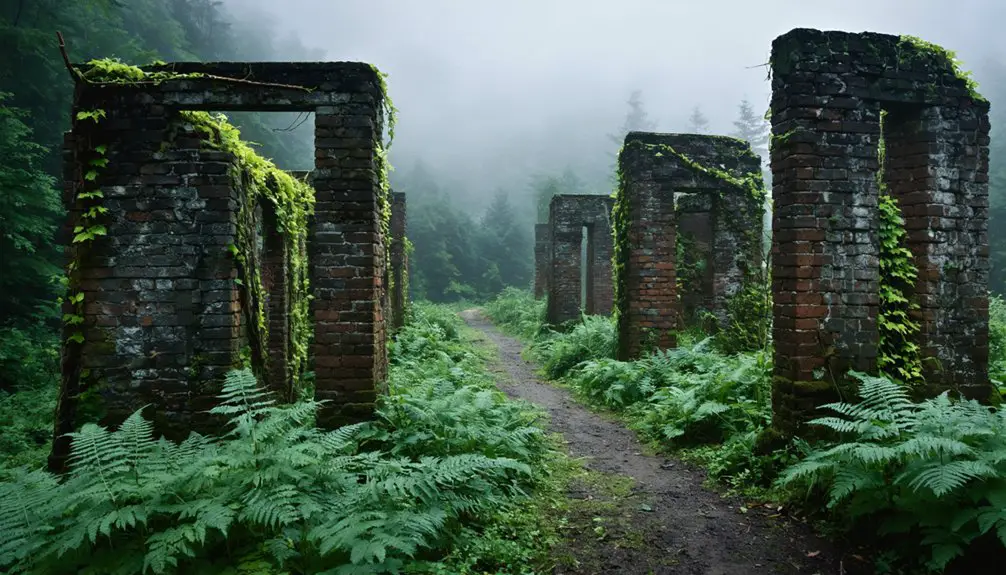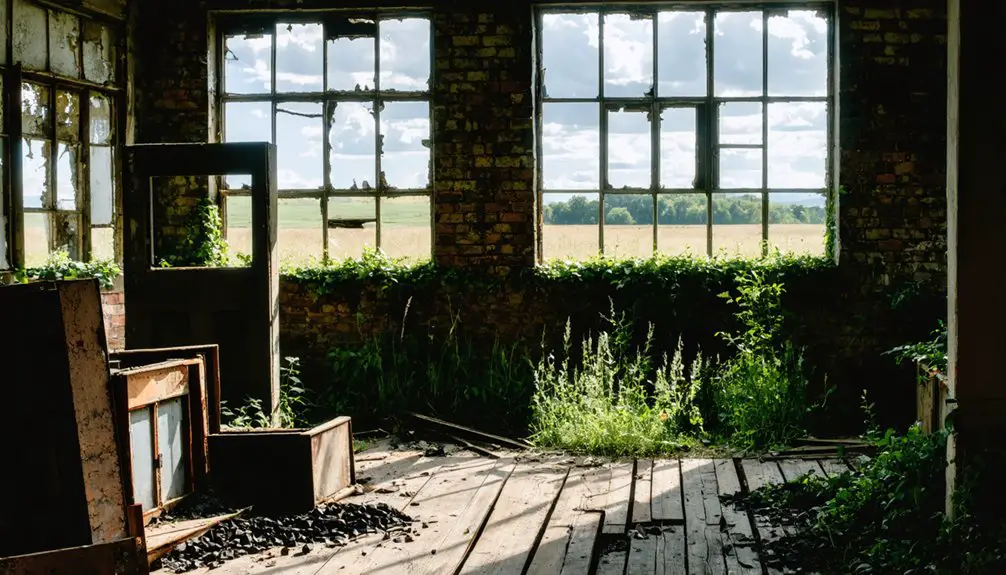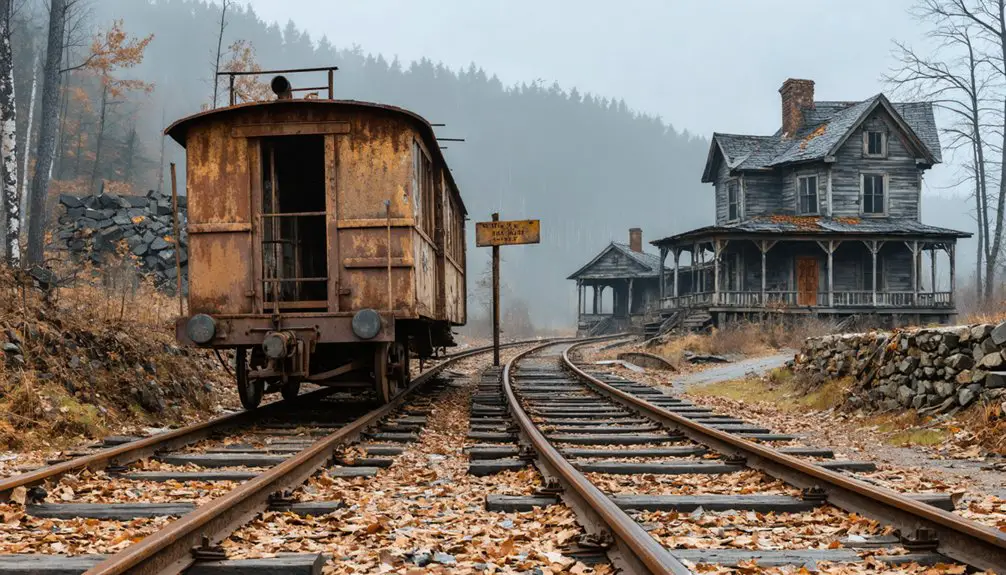You’ll find Fairbanks, Pennsylvania’s ghost town roots in its heyday as a bustling railroad stop along the Pennsylvania Railroad system. The town flourished through silver mining operations at the Grand Central Mining Company’s 30-stamp mill, while the wooden station served as an essential commerce hub. Native American tribes like the Lenape originally inhabited the area before European settlement. After rail service declined in 1946, the town gradually faded, but its historic structures still tell tales of frontier innovation.
Key Takeaways
- The Pennsylvania Railroad established Fairbanks as a vital transportation hub, with a wooden station serving passenger and freight operations.
- Mining operations, particularly the Grand Central Mining Company’s 30-stamp mill, made Fairbanks a thriving industrial center.
- The town’s economy relied heavily on silver extraction and railroad operations, with continuous dividend payments until 1946.
- Early settlers built communities along Lycoming, Larrys, and Pine Creeks, creating a self-reliant society through shared labor.
- Fairbanks declined after reduced rail traffic and mining activity, leaving architectural remains that showcase late 19th-century frontier building styles.
Historical Legacy of the Railroad Town
While many Pennsylvania railroad towns rose and fell with the expansion of rail networks, Fairbanks emerged as a notable stop along the Pennsylvania Railroad’s vast system that stretched over 11,640 miles by 1926.
You’ll find the town’s identity was deeply shaped by the railroad’s influence, as PRR’s infrastructure created an essential hub for passenger and freight transport. Historical documentation through glass plate slides from 1910 captured the essence of these railroad stations in their prime. The prominent wooden station became the heart of local commerce, attracting businesses and workers who relied on rail connections to larger markets in New York and Ohio.
Like many railroad towns of its era, Fairbanks thrived on the steady stream of travelers and commerce, with hotels and supporting businesses springing up to serve the railway’s needs. The station’s presence transformed Fairbanks into a bustling community center. The town’s strategic location along the tracks helped maintain continuous dividend payments from the railroad’s profitable operations until 1946.
Life in Early Fairbank Settlement
Before the railroad transformed Fairbanks into a bustling hub, early settlers carved out a life along the region’s key waterways. You’d find these pioneers scattered across a two-mile-wide, ten-mile-long valley, where Lycoming, Larrys, and Pine Creeks provided essential resources for early survival.
In this wilderness, you would’ve witnessed a remarkable blend of self-reliance and communal living. Settlers built log cabins, hunted in groups, and shared the work of clearing land. The settlement grew exponentially after gold was discovered near the trading post. Disease outbreaks from the Columbian Exchange severely impacted nearby native populations.
Life on the frontier balanced independence with community spirit, as settlers worked together while maintaining their individual homesteads.
They lived alongside Native American tribes, often exchanging knowledge and resources. Without formal government, they created their own rules and agreements, practicing de facto possession of the land.
The abundant natural resources and fertile valleys made life easier than in other colonial settlements, though the frontier’s challenges demanded constant adaptation and cooperation.
Economic Rise and Development
After Nathaniel Kellog Fairbank established the Grand Central Mining Company, Fairbanks quickly transformed into a thriving industrial center.
The town’s mining history centered around a 30-stamp mill that employed 35 men, making it the region’s largest operation. You’d find silver extraction at the heart of the local economy, drawing workers and investors alike. Similar to towns with anthracite coal deposits, natural resources drove rapid growth and development.
The railroad’s presence proved essential, as you could ship ore and supplies efficiently to broader markets. Thanks to Fairbank’s influence as a railroad stockholder, the town enjoyed excellent transportation access.
Local businesses flourished, from supply stores to mercantile shops, all supporting the mining operations. Much like other mining towns such as Centralia, the area’s economic stability depended heavily on resource extraction. However, economic fluctuations tied to mineral prices meant the town’s fortunes rose and fell with the mining industry’s success, setting the stage for later challenges.
Native American Origins and Displacement
You’ll find that before European settlement, Native American tribes like the Lenape, Susquehannocks, and Shawnee inhabited the region around present-day Fairbanks, establishing an intricate network of walking paths and trade routes.
These tribes navigated the area between the West Branch Susquehanna and Juniata rivers primarily for hunting and commerce, using both overland trails and dugout canoes for transportation. The Great Shamokin Path served as a crucial route connecting various indigenous settlements and hunting grounds.
As European colonization expanded in the 17th and 18th centuries, conflicts over land rights and fur trade led to the gradual displacement of these Native communities from their ancestral territories. Similar to the discovery of oil on Alaska’s North Slope, the land disputes intensified when valuable resources were found in Native territories.
O’Odham River Settlements
The ancestral lands of the Akimel O’odham people stretched across central Arizona‘s river valleys, where their settlements flourished from AD 1 to 1450.
You’ll find that their villages dotted the Gila River Valley from Florence to the Estrellas mountains, showcasing the Akimel O’odham culture’s mastery of desert agriculture through extensive irrigation systems.
- They engineered complex canal networks called “acequias” to divert river water
- Communities maintained their own irrigation systems without monetary exchange
- Their territory, Papagueria, extended from Sonora to the Gulf of California
- Villages cooperated on rebuilding projects and canal maintenance
These thriving settlements relied on sophisticated water management techniques, growing corn, beans, squash, cotton, and tobacco.
Their communal lifestyle centered on the rivers that sustained them, until later territorial changes disrupted their traditional ways. The Hispanic Period saw their villages concentrate primarily along the Gila River between 1694 and 1854.
At its peak during the Classic Period, their advanced agricultural systems supported a population of 50,000 to 60,000 people across the region.
Apache Territorial Pressures
Between 1000 and 1500 CE, Southern Athabaskan-speaking Apache peoples migrated from their northern homelands into diverse landscapes across the American Southwest.
You’ll find their settlements stretched from Eastern Arizona to West Texas, encompassing mountains, canyons, and plains where they developed a balanced way of life through hunting, foraging, and farming.
As Apache groups moved south, they faced territorial pressures from multiple directions.
You’d see intense Apache conflicts with Comanches, who aggressively expanded their dominance over the region called Comanchería.
The arrival of European settlers brought even more challenges, leading to violent displacement and forced removals.
Despite systematic attempts at their destruction, the Apache demonstrated remarkable territorial adaptation, using guerrilla warfare tactics and intimate knowledge of the landscape to resist Spanish, Mexican, and U.S. forces.
The Grand Central Mill Operations

The Grand Central Mill‘s five-acre site housed advanced stamp mill equipment that crushed and processed silver ore from the Tombstone mining district.
You’ll find evidence of the mill’s impressive scale in its extensive foundation remains and the documented employment of numerous workers under superintendent S.W. Woods by 1888.
The mill’s daily operations were coordinated through an early telephone connection to Tombstone, demonstrating its technological sophistication for the 1880s era.
Mill Equipment Layout
Engineered with remarkable precision, Grand Central Mill’s equipment layout reflected advanced industrial design principles of the early 1900s.
You’d find a carefully planned mill layout featuring European engineering standards and reinforced concrete foundations supporting massive machinery. The equipment arrangement followed a logical flow from ore intake to final processing, with primary crushers at the entry point and secondary processing equipment downstream.
- Water management systems integrated tanks and concrete vaults for sluicing operations
- Power transmission hubs centrally located to efficiently drive crushers and grinders
- Strategic placement of ore bins and hoppers near crushing zones to regulate material flow
- Structural divisions separated different milling stages for ideal workflow and safety
Workforce and Daily Operations
During the mill’s peak operations, skilled workers and laborers maintained a carefully orchestrated workflow at Grand Central Mill, where you’d find machinists tending to steam engines while miners and mill workers processed ore through the facility’s advanced equipment.
The workforce dynamics revolved around continuous operation, with shifts running 24/7 except for Sunday breaks when the jerker rod system rested.
You’d see supervisors coordinating daily briefings, while laborers handled the demanding tasks of ore transportation and processing.
Despite operational challenges like harsh conditions, dust, and intense heat from steam machinery, workers adapted to seasonal changes and equipment upgrades.
Communication relied heavily on face-to-face meetings and written logs, ensuring smooth coordination between mines, transportation networks, and mill operations.
Architectural Remains and Preservation
Remaining architectural structures in Fairbanks showcase late 19th to early 20th-century frontier building styles, with wooden frame buildings and clapboard siding dominating the landscape. The architectural significance of these structures lies in their use of locally sourced materials and practical designs that served the community’s needs.
- The 1920 Fairbanks schoolhouse stands as a representation of the town’s institutional architecture.
- Original buildings have faced substantial deterioration due to neglect and environmental factors.
- Preservation challenges include limited funding and ongoing threats from vandalism.
- Public structures like churches and railroad depots remain the most intact examples.
Today, you’ll find preservation efforts focused on stabilizing these remaining structures while maintaining their historical authenticity.
Local historical societies work to document and protect these tangible links to Pennsylvania’s mining and railroad heritage, though they face constant challenges from weather exposure and limited resources.
Natural Surroundings and Geography

Located at the junction of the San Pedro and Babocomari Rivers, Fairbanks occupies a distinctive riparian environment within Pennsylvania’s central and eastern regions.
You’ll find the natural environment characterized by grasslands and riverine flora typical of the area, with the waterways playing an essential role in the town’s historical development.
The geographical features surrounding Fairbanks include Appalachian mountain formations and sedimentary rock layers rich in coal deposits.
The area’s geological stability supported long-term Native American settlements before modern development began.
The confluence of the two rivers created ideal conditions for human habitation, providing reliable freshwater sources and fertile soil.
The town’s position near these water bodies hasn’t just shaped its physical landscape – it’s influenced settlement patterns and sustained the local ecosystem throughout its history.
Transportation Hub Impact
When the New Mexico and Arizona Railroad arrived in the early 1880s, Fairbank emerged as a significant transportation nexus between Benson and Nogales.
As you explore the town’s transportation evolution, you’ll discover how William Hall and Harry McKinney strategically developed the settlement around the railroad, establishing essential infrastructure that shaped the region’s commercial destiny.
- The depot became the heart of local commerce, facilitating livestock and mining shipments.
- Railroad operations attracted important businesses like blacksmiths and merchants.
- The town’s identity shifted through several names before settling on Fairbank.
- Logistics challenges eventually led to the town’s decline as transportation patterns changed.
The railroad’s presence transformed Fairbank into a bustling hub, but when rail traffic diminished, the town’s fortunes faded, highlighting the delicate relationship between transportation infrastructure and community survival.
Tourism and Heritage Experience

Today’s visitors to Fairbank Historic Townsite can experience a remarkably preserved slice of early 20th-century Arizona life through guided tours, interpretive trails, and museum exhibits.
You’ll find the site open Friday through Sunday from 9:30 AM to 4:30 PM, offering authentic ghost town tourism opportunities through weathered buildings and historic ruins.
As you explore the preserved schoolhouses, mills, and storefronts, interpretive placards guide you through 90 years of mining and railroad history.
The cultural experiences include docent-led tours sharing compelling stories of cattle baron conflicts and daily life in this once-thriving community.
You can hike riverside trails, visit the cemetery, and immerse yourself in hands-on museum exhibits.
Don’t forget to bring a picnic – you’ll want several hours to fully appreciate this carefully preserved piece of American heritage.
Frequently Asked Questions
What Happened to the Last Remaining Residents of Fairbank?
You’ll find displaced families relocated to nearby towns seeking jobs after the railroad’s closure, taking their community memories with them. The last residents left voluntarily by the 1970s before BLM took control.
Were There Any Notable Gunfights or Criminal Incidents in Fairbank?
You won’t find any documented gunfights or criminal incidents in the historical records. While coal mining regions sometimes experienced labor conflicts, there’s no evidence of notable violent episodes in Fairbank’s history.
How Did Seasonal Weather Patterns Affect Daily Railroad Operations?
With delays reaching 40% in winter months, you’d see significant weather impact on railroad scheduling through snow-blocked tracks, spring floods washing out rails, and summer heat causing dangerous track buckling.
What Artifacts Have Been Discovered During Archaeological Excavations at the Site?
You won’t find specific artifact records from Fairbanks, as there’s no documented archaeological excavation analysis. While excavation techniques were used at other ghost towns, this site lacks published findings about discovered items.
Did Any Famous Historical Figures Regularly Pass Through Fairbank?
In a region with over 50 ghost towns, you won’t find records of any famous visitors regularly passing through Fairbank. The town’s limited historical significance centered on local mining and railway operations.
References
- https://www.gvrhc.org/Library/FairbankGhostTown.pdf
- https://www.youtube.com/watch?v=Qj5LjacccJ0
- https://www.tripadvisor.com/Attraction_Review-g60778-d108693-Reviews-Fairbank_Historic_Townsite-Hereford_Arizona.html
- https://www.geotab.com/ghost-towns/
- https://en.wikipedia.org/wiki/List_of_ghost_towns_in_Pennsylvania
- https://en.wikipedia.org/wiki/Pennsylvania_Railroad
- http://www.prrths.com/newprr_files/Hagley/PRR1956.pdf
- https://phlf.org/fairbanks-feature-the-next-station-will-be-the-third-and-last-in-a-series/
- https://phlf.org/fairbanks-feature-the-next-station-will-be-the-second-in-a-series-of-three/
- http://www.prrths.com/newprr_files/Hagley/PRR1958.pdf



